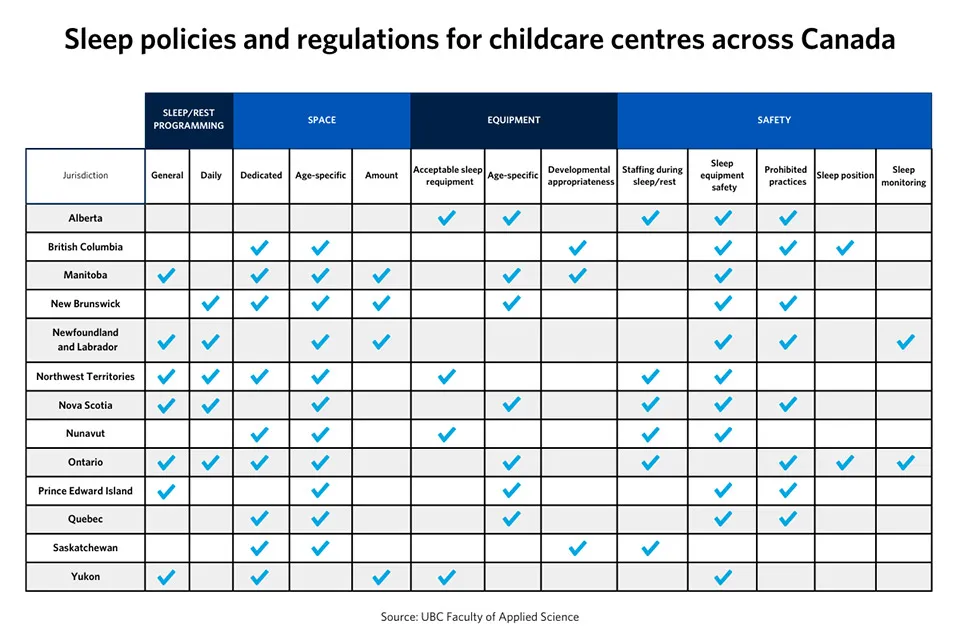Inconsistent sleep regulations in childcare could harm children’s health

Thousands of licensed childcare centres across Canada may not be ensuring that children get adequate, healthy sleep due to inconsistent sleep regulations.
A new UBC study led by pediatric sleep expert and School of Nursing Professor Emeritus Dr. Wendy Hall found that sleep regulations for licensed childcare facilities vary widely across Canadian provinces and territories, often leaving centres without clear guidelines to support children's sleep needs.
In this Q&A, Dr. Hall discusses why consistent national standards about sleep and rest are necessary to ensure children’s health and well-being, particularly in early care settings.
What does your study reveal about sleep regulations for daycare centres across Canada?
We found significant disparities in sleep-related regulations across provinces and territories. For instance, BC regulations lack specific guidelines about general or daily sleep programming, focusing instead on maintaining a safe sleep environment through factors like positioning, equipment safety and prohibited practices.
Alberta’s regulatory requirements do not specify sleep programming or space but do specify required staffing. In the Atlantic provinces, regulations vary about programming incorporating time for rest or sleep into the day.
Ontario regulations specify daily sleep amounts, dedicated age-specific sleep space and equipment, and sleep staffing, positioning and monitoring, and prohibited practices. Quebec regulations do not specify general or daily sleep programming, staffing during sleep/rest, sleep positioning or sleep monitoring.
There are operating manuals available to help licensees interpret regulations but many manuals are years out of date.

Why are these findings concerning?
Nearly three-quarters of children in Canada are in childcare settings—56 per cent are in some form of childcare and an additional 26 per cent are on waitlists. The lack of consistent regulations creates confusion regarding the appropriate number and length of naps/rest periods for children, particularly across various age groups. Although naps are crucial for development, many centres prioritize only one rest period per day, which may not meet infants’ needs or may exceed needs of three- to four-year-olds.
The definition of an “infant” also varies among provinces—the age range can vary from 12 to 24 months—which affects sleep space and equipment guidelines and children's development.
There are equity concerns as well. Children from lower socio-economic backgrounds who may not sleep as long at night can particularly benefit from access to naps in the day—but there are no consistent provisions for this across childcare in Canada.
What is a healthy amount of sleep? And what makes for safe sleep practices in childcare?
The Canadian 24-hour movement guidelines are a good starting point for the early years. These guidelines integrate children’s physical activity, sedentary time and sleep, recommending naps for infants and children under two years, and nap options for ages three to four.
Childcare centres also need to emphasize safe sleep practices, monitoring children during sleep to ensure their safety. Only regulations in BC and Ontario emphasize sleep positioning.
How can we improve sleep practices in childcare centres?
It's important to understand that each province or territory sets its own childcare regulations, which makes it challenging to create a consistent national approach. Many governments already struggle to provide adequate childcare and staff, making it challenging to improve sleep regulations. However, organizations like the Canadian Sleep Society and the Canadian Child Care Federation could advocate for better sleep regulations. Sleep should also be a key part of training for early childhood educators.
Parents can monitor their child’s sleep patterns, talk to childcare providers about their children’s needs and familiarize themselves with sleep guidelines. For example, American Academy of Sleep Medicine guidelines are useful in the context of recommendations for a 24-hour period, but do not separate naps from nighttime sleep. The Canadian 24-hour movement guidelines provide specific recommendations for naps within the broader sleep framework.



